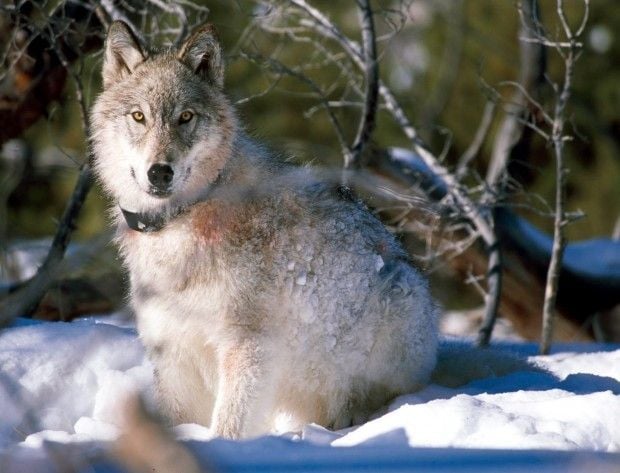2.29.2015
“One of the big issues in science-based management is to have clear goals,” said Scott Creel, a professor in the Department of Ecology at Montana State University in Bozeman and the lead author of the paper published in the December issue of Science magazine. “Avoiding being listed under the Endangered Species Act is one of the goals, but it’s not clear if that’s the only goal.”
Creel said the conservation policy paper is an “attempt to redefine what is a sustainable level” of wolf removal through hunting, trapping and those killed by stockmen.
Current state policies rely on an influx of animals from elsewhere to sustain populations, he said, but that doesn’t work well as states have different management policies and goals.
Montana’s wolf population was last estimated at a minimum of 554 in 134 packs, according to Montana Fish, Wildlife and Parks. Wolf numbers have been in a steady decline since peaking at 653 wolves in 130 packs in 2011.
“We know we probably miss 30 percent of them in our counts,” said John Vore, FWP’s Game Management Bureau chief, stressing that the actual number of wolves on the Montana landscape is probably significantly higher.
“When we had fewer wolves on the landscape it was easier to keep track of them,” he said.
Now, in places like the Kalispell region where the wolf populations have divided from 12 packs to 60, tracking those animals is much more difficult for the agency, Vore added.
Montana is in the sixth year of allowing hunting of wolves. After beginning conservatively, the state has bumped up the harvest quota and increased the number of licenses a hunter can buy to five. There’s also a lengthy trapping season for wolves.
Although last season more than 20,000 hunters bought a Montana wolf tag, only about 1 of every 100 actually killed a wolf. Last year’s harvest was 206 wolves. In the first year of hunting wolves in Montana in 2009, 72 wolves were killed.
“One of the big issues in science-based management is to have clear goals,” said Scott Creel, a professor in the Department of Ecology at Montana State University in Bozeman and the lead author of the paper published in the December issue of Science magazine. “Avoiding being listed under the Endangered Species Act is one of the goals, but it’s not clear if that’s the only goal.”
Creel said the conservation policy paper is an “attempt to redefine what is a sustainable level” of wolf removal through hunting, trapping and those killed by stockmen.
Current state policies rely on an influx of animals from elsewhere to sustain populations, he said, but that doesn’t work well as states have different management policies and goals.
Montana’s wolf population was last estimated at a minimum of 554 in 134 packs, according to Montana Fish, Wildlife and Parks. Wolf numbers have been in a steady decline since peaking at 653 wolves in 130 packs in 2011.
“We know we probably miss 30 percent of them in our counts,” said John Vore, FWP’s Game Management Bureau chief, stressing that the actual number of wolves on the Montana landscape is probably significantly higher.
“When we had fewer wolves on the landscape it was easier to keep track of them,” he said.
Now, in places like the Kalispell region where the wolf populations have divided from 12 packs to 60, tracking those animals is much more difficult for the agency, Vore added.
Montana is in the sixth year of allowing hunting of wolves. After beginning conservatively, the state has bumped up the harvest quota and increased the number of licenses a hunter can buy to five. There’s also a lengthy trapping season for wolves.
Although last season more than 20,000 hunters bought a Montana wolf tag, only about 1 of every 100 actually killed a wolf. Last year’s harvest was 206 wolves. In the first year of hunting wolves in Montana in 2009, 72 wolves were killed.
The paper points out that the International Union for Conservation of Nature, the world’s oldest and largest global environmental organization, “classifies a population segment as endangered if it holds fewer than 2,500 individuals and has declined by more than 20 percent in less than five years. In Idaho, delisting and subsequent legal harvest produced a 22.4 percent decline in population counts from 2008 to 2013.”
Idaho estimated its wolf population at the end of 2014 at 700 animals with 360 documented wolf mortalities. Wyoming counted 333 wolves with 64 mortalities. Oregon said it had 77 wolves and Washington 68, according to the U.S. Fish and Wildlife Service’s annual report.
The agency estimates the population of gray wolves in the United States at more than 5,500 animals, calling them “robust, stable and self-sustaining” on its website.
Creel said he’s worried that if wolves aren’t managed in a more sustainable means, the millions of dollars invested in re-establishing the large canines in the Northern Rockies will have been a waste.
While Idaho and Wyoming’s game management agencies seem geared to allow hunting of wolves to the lowest allowable population levels, Vore said FWP officials are proud of its agency’s program.
“We manage them just like we do other wildlife,” he said. “We look at the estimated population, how many conflicts we’ve had, and harvest in the past. It’s a balancing act with the overarching goal of maintaining a viable, connected population. And we’re well above those recommended (U.S. Fish and Wildlife Service) goals.
“Overall, the wolf story here in Montana is a success story. And we have been successful in reducing the number of conflicts with stockgrowers.”
Creel said the scientists aren’t trying to tell wildlife agencies what their wolf population goals should be, just that they should set some.
“The agencies may be reluctant to define a target because they’ll get pressure from both sides and that’s not a pleasant place to be,” he said.
source



No comments:
Post a Comment